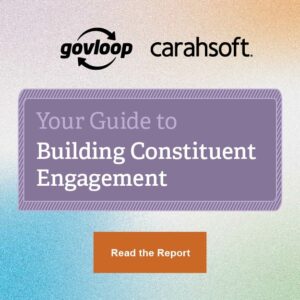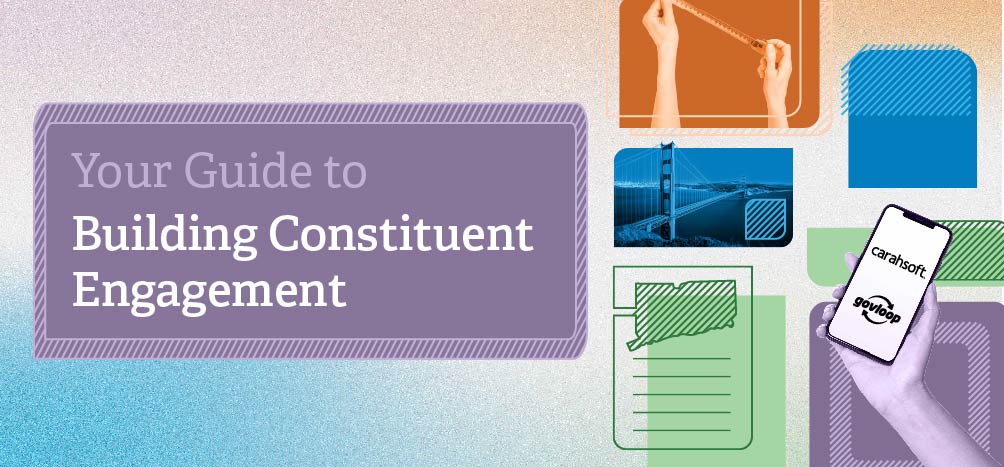In the past two years it seems like every function that could be done remotely was, and state and local agencies scrambled to ramp up digital services. Although organizations stepped up to the challenge in impressive ways, the situation was chaotic. Two of the experts we interviewed for this guide described elements of digital outreach as “the Wild West.” But now that the initial rush has passed, it’s time to look at how those community engagement initiatives contribute to the larger project of connecting — and building trust — with constituents. Although governments offer more ways than ever for constituents to engage, there’s still work to do. In this guide, leaders from state and local agencies share their challenges, solutions and recommendations for reaching residents in a digital and hybrid world, and industry experts offer their thoughts on the current landscape. Download the guide to learn how to improve accessibility, reach constituents and address various digital divides.
In San Francisco, Accessibility Means Better Engagement for Everyone
“Understand that accessibility helps everyone. Don’t assume you know who’s disabled, or what accessibility resources they’re using. Recognize that there are people whose impairment may be less apparent but who still benefit from accessibility measures. ‘It’s not a separate thing for a separate group of people,’ Kaplan said. Build accessibility into the whole organization. Don’t confine the work of accessibility to an office like MOD. Agencies need to develop their own internal expertise to deal with the more predictable accessibility issues in their work. Save the experts for when something complex comes along.”
Read more insights from Deborah Kaplan, Deputy Director of Programmatic Access in the San Francisco Mayor’s Office on Disability.
 How Automation Supports Better Community Engagement
How Automation Supports Better Community Engagement
“It might seem obvious, but the goal of constituent engagement is to get services to the people who need them and to include resident voices on policies that affect them. But often state and local government workers spend too much of their time wrangling incompatible systems, struggling to get data, and meeting reporting requirements. And while they’re doing that, they’re not serving the community. One way to lighten the burden is to automate time-consuming, repetitive processes. Another strategy is to provide platforms where people and processes can work together seamlessly.”
Read more insights from Craeg Strong, Chief Technology Officer at Ariel Partners.
Social Media Gives an Oklahoma Agency Its Voice
“In 2020, the Oklahoma Department of Wildlife Conservation adopted a unique—and often delightfully irreverent—approach to its use of social media. In lieu of the dry language so typical of government communications, the agency uses Twitter, Facebook, TikTok and Instagram to reach constituents through a mix of quirky humor, fun facts, and attractive photos and videos. The digital outreach works, and it’s a model for other agencies. The agency depends on communicating with and growing its target audience because it receives no state tax appropriations and is funded entirely by hunting and fishing licenses.”
Read more insights from the Oklahoma Department of Wildlife Conservation’s Communication and Education Supervisor, Kelly Adams, and Communication and Education Specialist, Smokey Solis.
A Trust-Engagement Model: Intuitive, Sequenced and Service-oriented
“Democratized analytics is the technological capability that enables data workers of various technical skill levels to leverage data and share its insights with other employees of various skill levels. Put simply, it’s analytics accessible for and inclusive to all. Unified analytics is technology that allows data workers to perform the entire analytic life cycle in one place. From data prep and blend, which identifies and combines data for descriptive, predictive and prescriptive analytics, to machine learning, an advanced form of AI that gets smarter over time — unified analytics allows a range of data transformation processes to be done in a single location, no matter the data source or type. No-code/low-code analytics is analytics that does not require coding skills to prep, clean, analyze and share data. And we’re not talking spreadsheets here.”
Read more insights from Alteryx’s Director of Solutions Marketing for the Public Sector, Andy MacIsaac.
Let’s Get Back to Basics for Collaboration
“Leveraging data can lead to more sequenced services, more graceful engagement, and the best outcomes for constituents. An optimal sequence, with natural steps between services, is cost-effective for both the user and agencies. That’s Red Hat’s focus as it works with agencies to implement open hybrid cloud approaches that integrate data, modernize system components and transform legacy systems. Cloud-based datasets that are accessible to agency personnel can help significantly. In recent years, Red Hat assisted the Tennessee Department of Human Services modernize to deliver better constituent experiences. The department wanted to improve the continuity of platforms, set open standards, and use adaptive, flexible, and broadly accessible technologies.”
Read more insights from Kevin Tunks of Red Hat.
(Contact-Free) Human Touch Helps Transform a Riverscape
“The city of Middletown, Connecticut, is focused on a decades-old goal: to revitalize and redevelop the riverfront. The underused Harbor Park area along the Connecticut River has great potential for residential, commercial and recreational use. But in the past, the city struggled to get feedback about the project from many stakeholders and constituents. That created a problem: How could the city design a community space without the input of the community? The Return to the Riverbend campaign, launched in fall 2021, yielded community input that the city used to create a master plan, released the following summer, for a new riverfront area.”
Read more insights from Brianna Skowera, Director of Information Systems for Middletown, Connecticut.
The Link Between Experience and Trust
“Think about a recent online interaction. Maybe you were buying something or applying for something. How did the experience make you feel? A great online experience is simple, fast and reliable. And when that great experience is consistent, it builds trust. That’s why it’s crucial to understand the link between government service and trust, said Dean Scontras, Vice President of State, Local and Education at Okta. ‘State and local agencies are modernizing their technology and transforming the way they serve their residents,’ Scontras said. Identity and access management (IAM) are critical infrastructure for digital services.”
Read more insights from Dean Scontras, Vice President for State, Local and Education at Okta.
North Carolina Breaks Down the Digital Divide
“Think of ‘digital divide,’ and it’s likely that a lack of access to internet connectivity and/or devices comes to mind. That’s certainly part of it. But the North Carolina Division of Broadband and Digital Equity adds another aspect: digital literacy. What good is a connected smartphone if you don’t know how to use it? Annette Taylor, Director of the division’s Office of Digital Equity and Literacy, understands. Her 72-year-old mother has a computer but is reluctant to use the internet. That became problematic during the pandemic when a digital pay stub was the only way she could see how much ‘COVID pay’ she was earning from her temporarily shuttered employer.”
Read more insights from Annette Taylor, Director, Office of Digital Equity and Literacy at the North Carolina Division of Broadband and Digital Equity.
How Voice Recognition Can Improve Constituent Satisfaction
“Today, every government organization needs to be where the public is — and that means being everywhere. Meeting customers on voice, digital, and messaging channels, and providing a consistent, contextual, convenient experience across every one. In one case, Nuance worked with a government agency that was struggling to handle incoming calls. They answered less than half, with the others getting a busy signal or a message asking them to call back later. Using Nuance’s solutions, they’re now able to answer all their incoming calls, and nearly half are handled within the interactive voice response (IVR) system. ‘Citizens are calling in, getting the information they need, and never talking with a customer service rep,’ Brodsky said.”
Read more insights from Nuance Communications’ Regional Vice President, Government Sales, Russell Brodsky; Senior Principal, Industry Solutions Marketing and Strategy, Vance Clipson; and Director of Professional Services, Joseph Solt.
San Antonio Deepens Trust With Constituents
“Let’s say you launch a constituent engagement initiative and within one year you see a significant rise across various metrics: website hits, comments received and event registrations. Do you call it a success? For Alanna Reed, San Antonio’s Director of Communications and Engagement, numbers tell only part of the story. San Antonio launched an initiative called SASpeakUp in 2015 to gather better input on the city’s budget and its services. Although the city held public meetings for that purpose, city officials noticed that the same people were attending all of them. Through SASpeakUp, they provided numerous channels for input, including a website, social media and in-person meetups.”
Read more insights from Dean Scontras, Vice President for State, Local and Education at Okta.
Download the full GovLoop Guide for more insights from these state and local government thought leaders and additional government interviews, historical perspectives and industry research on the future of data.








